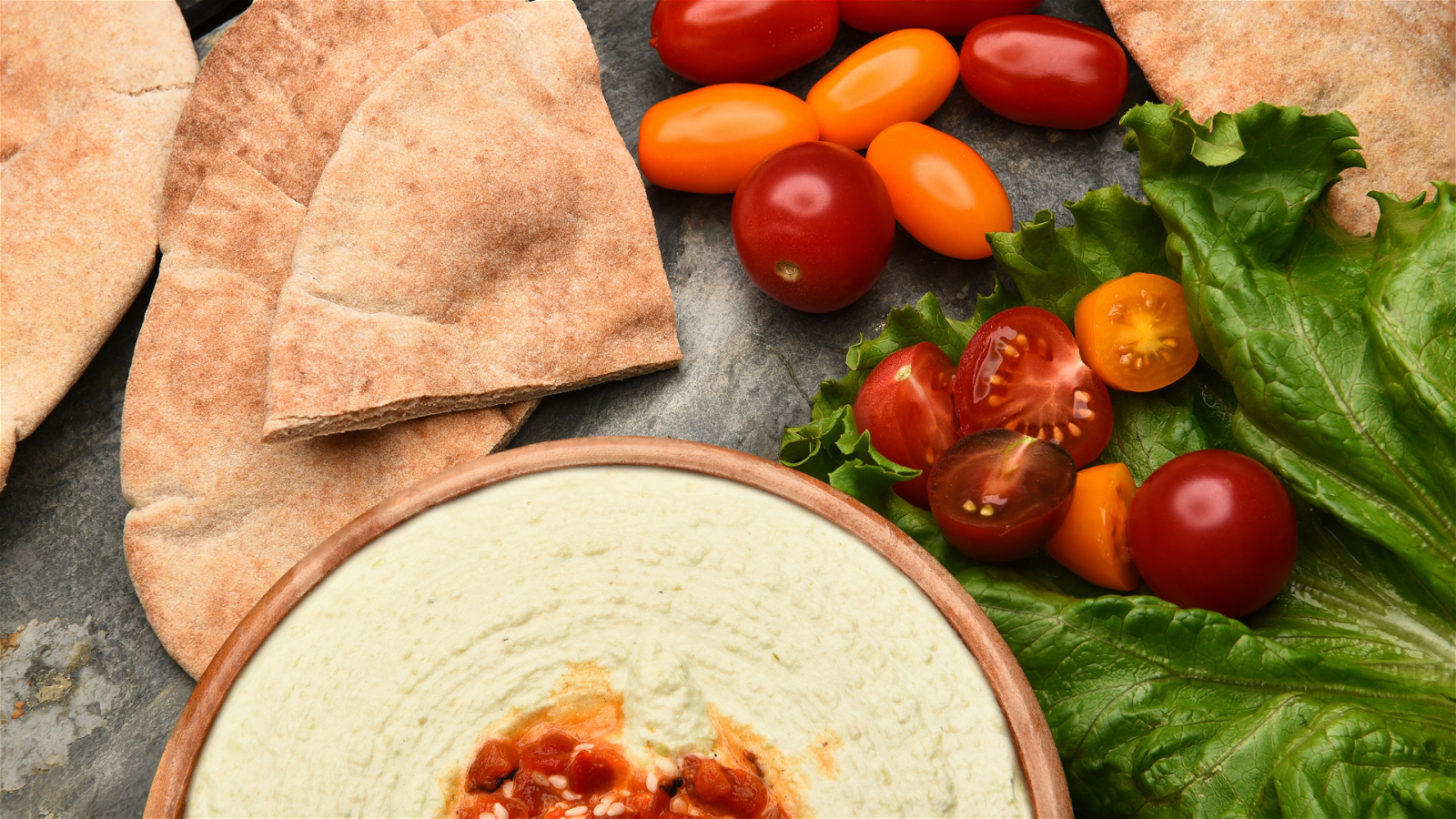Pita Bread and Hummus

Pita Bread and Hummus
Rated 5 stars by 1 users
Category
Lunch
Servings
10
Prep Time
2 hours
Cook Time
3-4 minutes
Calories
376

Ingredients
-
45 grams (½ cup) all purpose flour
-
30 grams (¼ cup) water, room temperature
-
0.5 grams (generous pinch) instant yeast
-
205 grams (1 ¾ cups) whole wheat flour
-
205 grams (1 ¾ cups) all-purpose or bread flour
-
13 grams (2 teaspoons) fine sea or table salt
-
6 to 7 grams (2 teaspoons) instant yeast
-
30 grams (2 tablespoons) olive oil
-
360 grams (1 1/2 cups) water, room temperature
-
1 - 15½ oz. can chickpeas (garbanzo beans), drained and rinsed
-
1 large lemon
-
1 garlic clove, grated finely
-
1/2 cup tahini, stirred
-
3/4 teaspoon kosher salt, plus more to taste
-
1/2 tablespoon sumac
-
1/4 teaspoon ground cumin
-
2 tablespoons water
-
3 tablespoons extra-virgin olive oil, plus more for drizzling
-
sesame seeds (for serving)
For the Poolish
For the Dough
For Hummus (makes about 2 cups)
Directions
- Step 1
After two hours, remove the cover from the bowl. The poolish should have slightly more volume along with some air bubbles.
Step 2
Combine the poolish with the remaining dough ingredients in the bowl of a stand mixer fitted with the dough hook. Mix on a medium low speed until everything is just combined and the flour looks well hydrated. Continue mixing on a medium speed until the dough comes cleanly from the side of the bowl, about 10 minutes. It should look uniform, smooth and feel soft to the touch. If the dough feels very sticky, or conversely very dry, add a bit of flour or a bit of water to adjust the consistency until it’s just tacky to the touch. (Err on the side of higher hydration; the pita won’t get their signature pocket if the dough is too dry!)
Step 3
At this point, place your kneaded dough into a new and well oiled large bowl. With your hands, apply a thin layer of oil to the top of the dough. Cover the bowl with a towel or plastic wrap and set aside to proof for 30 minutes in a very warm, draft free spot, such as a (closed) window sill or inside of your oven with the light on. Your dough should roughly double in size.
Step 4
Preheat your oven to 475°F. Place a baking stone, baking steel or cast iron skillet on an oven rack located in the bottom third of your oven. (Conversely, you can cook the pita on a very hot cast iron pan on the stovetop, they just won’t puff up quite as much as they will in the oven.)
Step 5
After your dough has roughly doubled in size, transfer it to a very lightly floured work surface then divide it into 10 pieces. Shape each piece into a ball and flatten slightly with the palm of your hand into a disk. Dust them with a little flour and leave them on your work surface, covered with one large piece of plastic wrap and allow them to rest for 10 minutes at room temperature.
Step 6
Once rested, use a rolling pin to roll each disk into a rough circle shape. They should be very thin, ⅛ to ¼ inch thick. (You can start with the first few you’re going to bake off and roll the next set as you’re baking the previously rolled ones.)
Step 7
To bake, put the dough rounds directly on the stone, steel or skillet, no more than 2 or 3 at a time to avoid overcrowding. Bake each round of pita for 3-4 minutes, until they are completely puffed up and just very lightly browning. If the pitas are not puffing up, try spraying with a small amount of water before putting in the oven to bake. Continue baking until all of your dough is used, allowing the oven to reheat for a minute or two between batches.
Step 8
Serve warm pita alongside the freshly made hummus, mixed vegetables or as part of a complete meal with your protein of choice (recipe below).
For the Hummus
- Step 10
Allow the chickpeas to dry thoroughly by air or by pressing them lightly with paper towels.
Transfer the chickpeas to the bowl of a food processor along with the juice of half a lemon (reserving the other half if needed for taste), grated garlic, tahini, salt, sumac, cumin and water. Blend until smooth.
With the food processor on, slowly stream in the olive oil. Continue to process until the hummus is really smooth and creamy. Once the texture is right, stop the processor and taste the hummus, adding more salt or lemon juice to your preference. Serve in a shallow bowl topped with a few pinches of toasted sesame seeds and a few more drizzles of olive oil.
Step 11
Allow the chickpeas to dry thoroughly by air or by pressing them lightly with paper towels.
Step 12
Transfer the chickpeas to the bowl of a food processor along with the juice of half a lemon (reserving the other half if needed for taste), grated garlic, tahini, salt, sumac, cumin and water. Blend until smooth.
Step 13
With the food processor on, slowly stream in the olive oil. Continue to process until the hummus is really smooth and creamy. Once the texture is right, stop the processor and taste the hummus, adding more salt or lemon juice to your preference. Serve in a shallow bowl topped with a few pinches of toasted sesame seeds and a few more drizzles of olive oil.
Step 14
Nutrition
Calories 376, Carbs 50 grams, Fat 15 grams, Protein 12 grams



